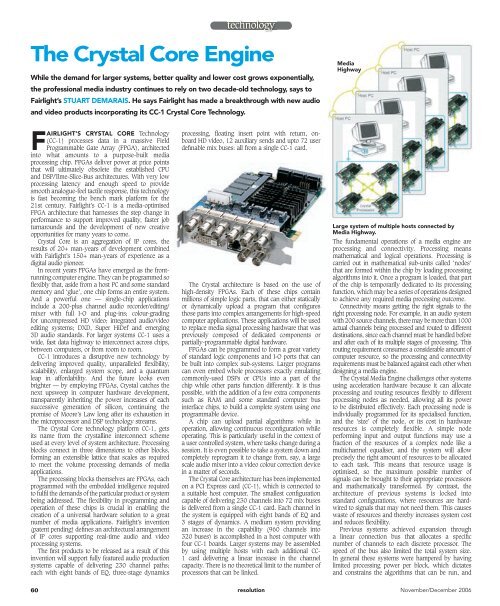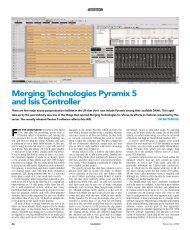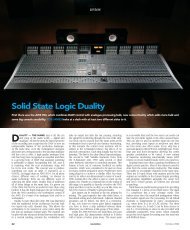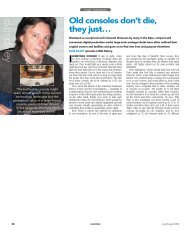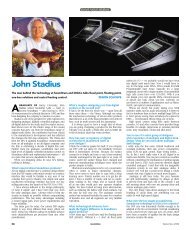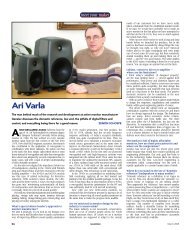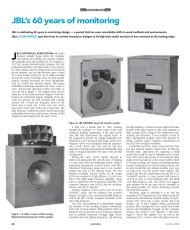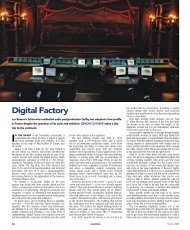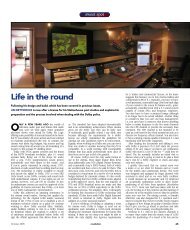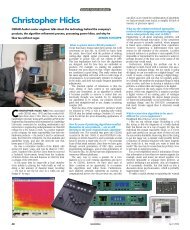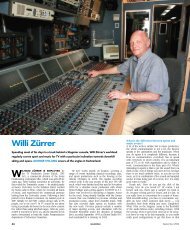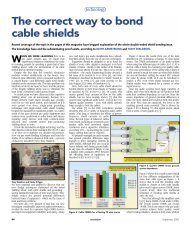The crystal core engine - Resolution
The crystal core engine - Resolution
The crystal core engine - Resolution
Create successful ePaper yourself
Turn your PDF publications into a flip-book with our unique Google optimized e-Paper software.
technology<br />
<strong>The</strong> Crystal Core Engine<br />
While the demand for larger systems, better quality and lower cost grows exponentially,<br />
the professional media industry continues to rely on two decade-old technology, says to<br />
Fairlight’s STUART DEMARAIS. He says Fairlight has made a breakthrough with new audio<br />
and video products incorporating its CC-1 Crystal Core Technology.<br />
Media<br />
Highway<br />
FAIRLIGHT’S CRYSTAL CORE Technology<br />
(CC-1) processes data in a massive Field<br />
Programmable Gate Array (FPGA), architected<br />
into what amounts to a purpose-built media<br />
processing chip. FPGAs deliver power at price points<br />
that will ultimately obsolete the established CPU<br />
and DSP/Time-Slice-Bus architectures. With very low<br />
processing latency and enough speed to provide<br />
smooth analogue-feel tactile response, this technology<br />
is fast becoming the bench mark platform for the<br />
21st century. Fairlight’s CC-1 is a media-optimised<br />
FPGA architecture that harnesses the step change in<br />
performance to support improved quality, faster job<br />
turnarounds and the development of new creative<br />
opportunities for many years to come.<br />
Crystal Core is an aggregation of IP <strong>core</strong>s, the<br />
results of 20+ man-years of development combined<br />
with Fairlight’s 150+ man-years of experience as a<br />
digital audio pioneer.<br />
In recent years FPGAs have emerged as the frontrunning<br />
computer <strong>engine</strong>. <strong>The</strong>y can be programmed so<br />
flexibly that, aside from a host PC and some standard<br />
memory and ‘glue’, one chip forms an entire system.<br />
And a powerful one — single-chip applications<br />
include a 200-plus channel audio recorder/editing/<br />
mixer with full I-O and plug-ins; colour-grading<br />
for uncompressed HD video; integrated audio/video<br />
editing systems; DXD, Super HiDef and emerging<br />
3D audio standards. For larger systems CC-1 uses a<br />
wide, fast data highway to interconnect across chips,<br />
between computers, or from room to room.<br />
CC-1 introduces a disruptive new technology by<br />
delivering improved quality, unparalleled flexibility,<br />
scalability, enlarged system scope, and a quantum<br />
leap in affordability. And the future looks even<br />
brighter — by employing FPGAs, Crystal catches the<br />
next upsweep in computer hardware development,<br />
transparently inheriting the power increases of each<br />
successive generation of silicon, continuing the<br />
promise of Moore’s Law long after its exhaustion in<br />
the microprocessor and DSP technology streams.<br />
<strong>The</strong> Crystal Core technology platform CC-1, gets<br />
its name from the <strong>crystal</strong>line interconnect scheme<br />
used at every level of system architecture. Processing<br />
blocks connect in three dimensions to other blocks,<br />
forming an extensible lattice that scales as required<br />
to meet the volume processing demands of media<br />
applications.<br />
<strong>The</strong> processing blocks themselves are FPGAs, each<br />
programmed with the embedded intelligence required<br />
to fulfil the demands of the particular product or system<br />
being addressed. <strong>The</strong> flexibility in programming and<br />
operation of these chips is crucial in enabling the<br />
creation of a universal hardware solution to a great<br />
number of media applications. Fairlight’s invention<br />
(patent pending) defines an architectural arrangement<br />
of IP <strong>core</strong>s supporting real-time audio and video<br />
processing systems.<br />
<strong>The</strong> first products to be released as a result of this<br />
invention will support fully featured audio production<br />
systems capable of delivering 230 channel paths;<br />
each with eight bands of EQ, three-stage dynamics<br />
processing, floating insert point with return, onboard<br />
HD video, 12 auxiliary sends and upto 72 user<br />
definable mix buses: all from a single CC-1 card.<br />
<strong>The</strong> Crystal architecture is based on the use of<br />
high-density FPGAs. Each of these chips contain<br />
millions of simple logic parts, that can either statically<br />
or dynamically upload a program that configures<br />
those parts into complex arrangements for high-speed<br />
computer applications. <strong>The</strong>se applications will be used<br />
to replace media signal processing hardware that was<br />
previously composed of dedicated components or<br />
partially-programmable digital hardware.<br />
FPGAs can be programmed to form a great variety<br />
of standard logic components and I-O ports that can<br />
be built into complex sub-systems. Larger programs<br />
can even embed whole processors exactly emulating<br />
commonly-used DSPs or CPUs into a part of the<br />
chip while other parts function differently. It is thus<br />
possible, with the addition of a few extra components<br />
such as RAM and some standard computer bus<br />
interface chips, to build a complete system using one<br />
programmable device.<br />
A chip can upload partial algorithms while in<br />
operation, allowing continuous reconfiguration while<br />
operating. This is particularly useful in the context of<br />
a user controlled system, where tasks change during a<br />
session. It is even possible to take a system down and<br />
completely reprogram it to change from, say, a large<br />
scale audio mixer into a video colour correction device<br />
in a matter of seconds.<br />
<strong>The</strong> Crystal Core architecture has been implemented<br />
on a PCI Express card (CC-1), which is connected to<br />
a suitable host computer. <strong>The</strong> smallest configuration<br />
capable of delivering 230 channels into 72 mix buses<br />
is delivered from a single CC-1 card. Each channel in<br />
the system is equipped with eight bands of EQ and<br />
3 stages of dynamics. A medium system providing<br />
an increase in the capability (960 channels into<br />
320 buses) is accomplished in a host computer with<br />
four CC-1 boards. Larger systems may be assembled<br />
by using multiple hosts with each additional CC-<br />
1 card delivering a linear increase in the channel<br />
capacity. <strong>The</strong>re is no theoretical limit to the number of<br />
processors that can be linked.<br />
Large system of multiple hosts connected by<br />
Media Highway.<br />
<strong>The</strong> fundamental operations of a media <strong>engine</strong> are<br />
processing and connectivity. Processing means<br />
mathematical and logical operations. Processing is<br />
carried out in mathematical sub-units called ‘nodes’<br />
that are formed within the chip by loading processing<br />
algorithms into it. Once a program is loaded, that part<br />
of the chip is temporarily dedicated to its processing<br />
function, which may be a series of operations designed<br />
to achieve any required media processing outcome.<br />
Connectivity means getting the right signals to the<br />
right processing node. For example, in an audio system<br />
with 200 source channels, there may be more than 1000<br />
actual channels being processed and routed to different<br />
destinations, since each channel must be handled before<br />
and after each of its multiple stages of processing. This<br />
routing requirement consumes a considerable amount of<br />
computer resource, so the processing and connectivity<br />
requirements must be balanced against each other when<br />
designing a media <strong>engine</strong>.<br />
<strong>The</strong> Crystal Media Engine challenges other systems<br />
using acceleration hardware because it can allocate<br />
processing and routing resources flexibly to different<br />
processing nodes as needed, allowing all its power<br />
to be distributed effectively. Each processing node is<br />
individually programmed for its specialised function,<br />
and the ‘size’ of the node, or its cost in hardware<br />
resources is completely flexible. A simple node<br />
performing input and output functions may use a<br />
fraction of the resources of a complex node like a<br />
multichannel equaliser, and the system will allow<br />
precisely the right amount of resources to be allocated<br />
to each task. This means that resource usage is<br />
optimised, so the maximum possible number of<br />
signals can be brought to their appropriate processors<br />
and mathematically transformed. By contrast, the<br />
architecture of previous systems is locked into<br />
standard configurations, where resources are hardwired<br />
to signals that may not need them. This causes<br />
waste of resources and thereby increases system cost<br />
and reduces flexibility.<br />
Previous systems achieved expansion through<br />
a linear connection bus that allocates a specific<br />
number of channels to each discrete processor. <strong>The</strong><br />
speed of the bus also limited the total system size.<br />
In general these systems were hampered by having<br />
limited processing power per block, which dictates<br />
and constrains the algorithms that can be run, and<br />
60 resolution November/December 2006
technology<br />
having a fixed architecture, which commits resources<br />
to processes even when they are not needed. <strong>The</strong><br />
Crystal architecture connects in three dimensions,<br />
allowing almost limitless expansion. It can connect<br />
multiple circuit boards within a single computer, or<br />
multiple computers, fusing them into a single system<br />
of immense power. In addition, its reprogrammable<br />
allocation of channel connections to processing<br />
nodes ensures the flexibility to make full use of the<br />
processing power.<br />
Unlike the technology it replaces, which is based<br />
on interconnected circuit boards using dedicated<br />
DSPs, the Crystal Media Engine will be a complete<br />
architecture on a single chip, with the option of<br />
seamlessly linking other chips to the first when extra<br />
capacity is required.<br />
Using FPGA technology has allowed Fairlight to<br />
further increase the quality of audio manipulation by<br />
implementing a new processing paradigm known as<br />
Dynamic <strong>Resolution</strong> Optimisation (DRO). <strong>The</strong> DRO<br />
architecture enables the optimal precision needed for<br />
a specific task to be used within each of its Nodes.<br />
This design means that ultra-precise 72-bit fixed<br />
point can be used in CC-1’s EQ node, while optimal<br />
36-bit floating point can be used in the mixing node.<br />
In areas where extreme precision is not required,<br />
CC-1 adjusts the precision accordingly. For example,<br />
audio metering is more than adequately specified at<br />
16-bit fixed point. DRO is unique, and is patented by<br />
Fairlight worldwide.<br />
<strong>The</strong> CC-1 media <strong>engine</strong>s powers the Dream II product<br />
family. <strong>The</strong>se products form a range of audio production<br />
tools for recording, editing and mixing applications.<br />
All initial product outcomes will be delivered from a<br />
single CC-1 card that will connect with any of the four<br />
available surface technologies (SatelliteAV, StationPlus,<br />
Constellation-XT and Anthem). <strong>The</strong> end user’s physical<br />
I-O requirement is supported with the SX-48 or SX-20<br />
modular I-O products.<br />
Each CC-1 <strong>engine</strong> includes a 1U SX-20 Sync and<br />
I-O unit that provides analogue and digital I-Os<br />
together with machine control and sync capabilities.<br />
In addition, each CC-1 card can support up-to seven<br />
multiplexed data connections. <strong>The</strong>se may be used in<br />
the form of 64-channel BNC MADI connections or<br />
as SDI video data streams. If MADI is employed this<br />
equates to 448 physical inputs and outputs per CC-1<br />
card. <strong>The</strong>se MADI ports can be connected to Fairlight’s<br />
SX-48 modular remote I-O or any other third party<br />
MADI-equipped I-O platform.<br />
<strong>The</strong> initial Dream II products provide the capability<br />
to connect up to 4 x SX-48s delivering up to 192<br />
physical inputs and outputs.<br />
Fairlight’s SX 20 is a versatile ‘Sync I-O Toolbox’,<br />
and is a required component of any base CC-1<br />
system. <strong>The</strong> SX-20 includes two mic/instrument<br />
preamps plus two additional balanced analogue<br />
inputs, 12 balanced analogue outputs, four digital<br />
inputs and eight digital outputs. In addition, SX-<br />
20 includes powerful simultaneous independent<br />
multimachine 9-pin control. <strong>The</strong> SX-20 provides<br />
for sync at any frame rate including HD trilevel<br />
sync, video sync, Word clock, AES and LTC. <strong>The</strong><br />
unit also generates LTC at any standard rate.<br />
When combined with CC-1, SX-20 provides all the<br />
capabilities required for a wide variety of audio<br />
production and postproduction tasks.<br />
Anthem 230-channel large format mixing powered<br />
by a single CC-1 card.<br />
Fairlight’s SX-48 Signal Exchange extends the<br />
CC-1 platform with flexible and cost-effective I-O.<br />
Up to four SX-48 units can be connected to a single<br />
CC-1 card via MADI providing up to 192 channels<br />
of discrete I-O per <strong>engine</strong>. SX-48 is designed to<br />
accommodate all standard sampling frequencies<br />
from 44.1kHz to 192kHz. Fairlight’s I-O can be<br />
installed in 8-channel modular blocks, allowing<br />
combinations of up to six cards of analogue and/or<br />
digital I-O to be mixed together in each SX-48 unit or<br />
added later if required. SX-48 locks to external sync<br />
at any frame rate and accepts HD trilevel sync, video<br />
sync, Word clock or AES as references. Fairlight’s<br />
Total Studio Connectivity Protocol (TSCP) allows<br />
intelligent management of all SX-48 I-O resources<br />
on the TSCP network. ■<br />
November/December 2006<br />
resolution


